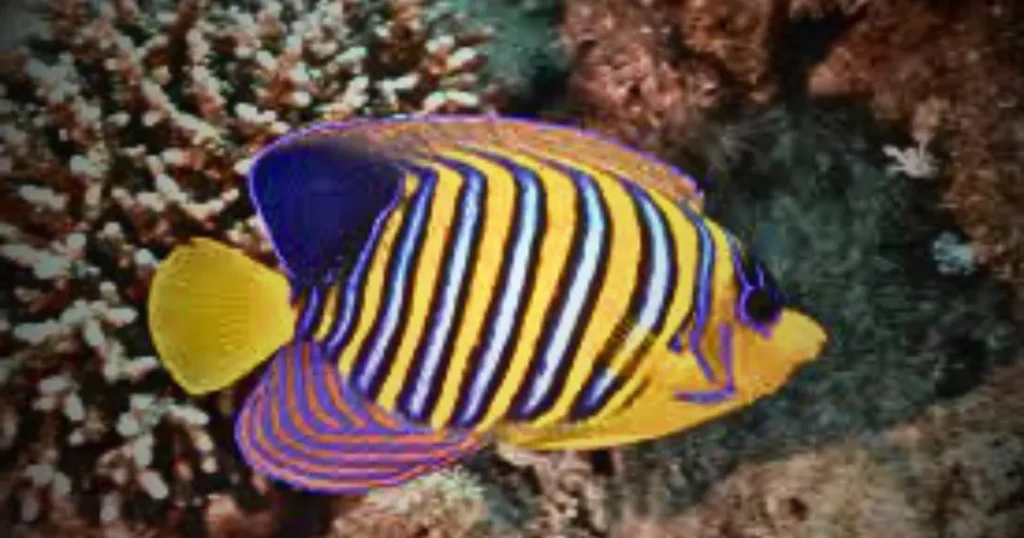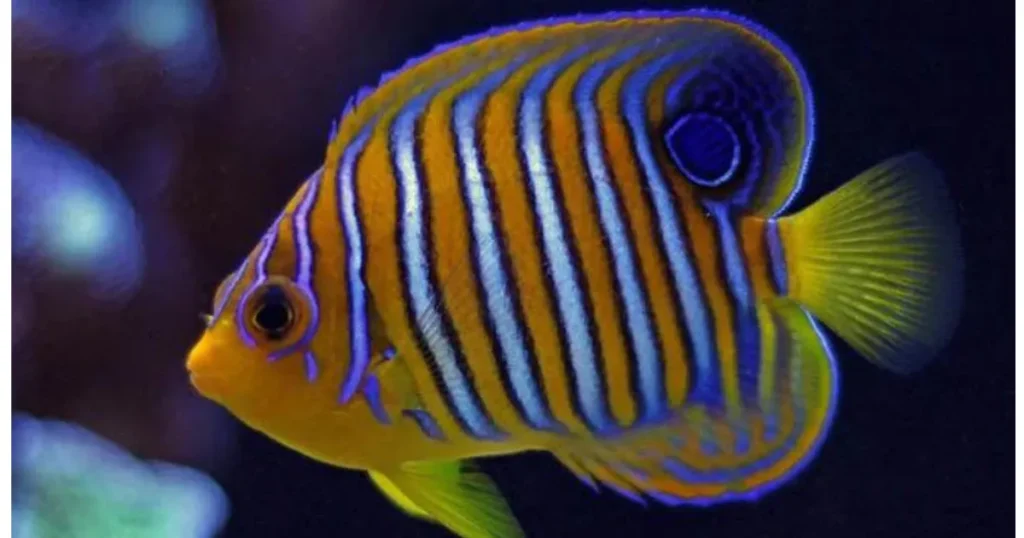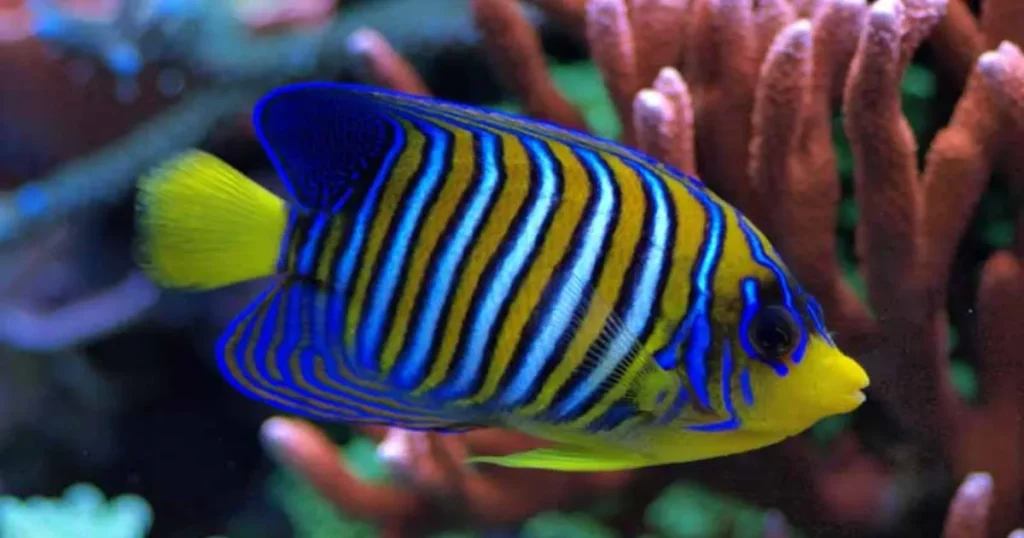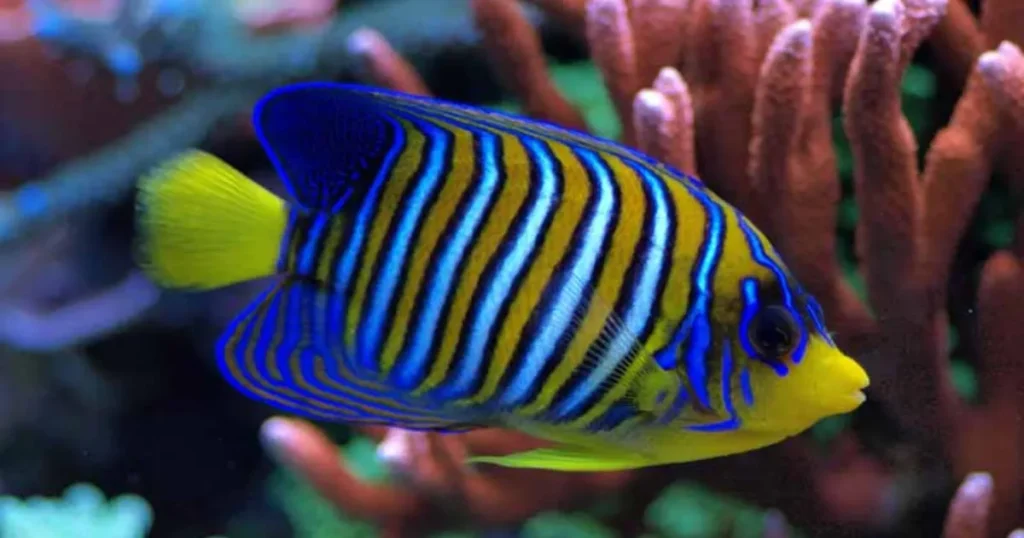With their deep black and yellow striped bodies and flowing fins, regal angelfish add unmatched tropical beauty to home aquariums. Also known as the pygoplites diacanthus, regal or Pygoplites diacanthus hail from the reefs of the Red Sea and Indian Ocean. While stunning to behold, these fish require diligent care and specific tank conditions to thrive in captivity. This complete guide covers everything you need to know about caring for regal angelfish, from ideal tank size to diet and disease prevention. Follow these tips, and your regal angelfish will grace your tank for years to come.
An Overview of the Graceful Pygoplites Diacanthus (Regal Angelfish).

Regal belong to the family Pomacanthidae. Their scientific name is Pygoplites diacanthus. These fish dwell around coral reefs in the wild, often near caves and ledges. They are found in tropical waters of the Red Sea and Indian Ocean at depths of 10-70 feet. Regal angelfish feed on sponges, tunicates, jellyfish and algae off the reef.
While some regal available in the trade are wild-caught, captive-bred varieties are becoming more common. This helps reduce environmental stress on wild populations.
The Appeal of Keeping Regal.
It’s easy to see why regal angelfish appeal to advanced aquarists. Their unique patterns and graceful, angled bodies make them true showstoppers. These fish have complex personalities and are highly intelligent. Their natural behaviors like picking at algae are fascinating to observe.
However, it is not suitable for beginners. They need ample space, pristine water quality, specialized feeding, and particular tankmates. Providing the right care maximizes their lifespan, health, and colors.
Fish Keeping Difficulty.
Keeping regal in a reef aquarium can be challenging, and they are generally recommended for experienced aquarists. These angelfish are delicate, reluctant to feed, and very shy and reclusive. They require a large tank of at least 100 gallons or more with plenty of hiding places created by rockwork. The water quality must be pristine, with a pH of 8.1 or higher and stable temperature and salinity parameters. Regal angelfish have specific dietary requirements, making it important to provide them with a varied diet that includes sponge material.
Regal Angelfish Size and Lifespan.
In the wild, regal can reach lengths over 18 inches. Those kept in home aquariums are usually a bit smaller, around 12 inches long once mature. These fish grow fairly quickly in optimal conditions. Juveniles may gain over an inch per month until they near full size after 12-18 months.
They typically reach sexual maturity around 5 to 6 inches in length. In terms of lifespan, they can live for 14 years or more in a well-maintained aquarium. However, their longevity is highly dependent on proper care, a suitable environment, and a balanced diet.
Captive Bred Regal.

Captive breeding of regal is challenging, and most specimens available in the aquarium trade are wild-caught. However, there have been advancements in the captive breeding of regal angelfish, and some responsible breeders have successfully produced offspring. Captive-bred specimens are generally considered hardier and more adaptable to aquarium conditions.
Regal Angelfish Care Essentials.
Ideal Tank Size.
Given their large mature dimensions, regal angelfish need ample swimming space. The minimum recommended tank size for one angelfish is 125 gallons.
For each additional fish, add around 70 gallons. This allows them to establish distinct territories and reduces aggression.
Vertically oriented tanks are ideal. Regal like to swim in an upright posture. Aim for a tank height of 18 inches or greater.
Water Parameters for Tanks.
Originating from tropical reef environments, regal angelfish thrive in warm, alkaline water. Maintain the following water parameters:
- Temperature between 76-82°F
- pH of 8.1-8.4
- Alkalinity 8-12 dKH
- Salinity of 1.020-1.025 specific gravity with marine salt
warmer temperatures near the higher end of this range promote faster growth. Cooler temperatures can be used for mature fish to extend lifespan.
Provide strong water movement using powerheads and wavemakers. This mimics their natural reef habitat. Use protein skimmers, live rock, and sumps to keep water crystal clear.
Perform 25% weekly water changes. Test calcium, nitrates, phosphates, and trace elements regularly. Stable, pristine water is crucial for their health.
Insights into the Species’ Temperature Preferences.
When keeping regal angelfish, it’s important to understand their preferences and adaptations related to water temperature. This provides insights into managing suitable tank temperatures for them to thrive.
In the wild, regal inhabit tropical coral reefs with temperatures around 78-84°F. However, they are capable of withstanding broader temperature swings. Regal angelfish can tolerate temperatures from 72-87°F. But they do best and show optimal growth, coloration, and activity in their ideal range of 76-82°F.
Temperatures on the warmer end of this range, near 80-82°F, are preferred especially for juveniles. Warmer waters speed up their metabolism and growth rate. As they mature, they can be acclimatized to slightly cooler temps of 76-78°F. This may extend lifespan for older specimens.
Sudden temperature swings above 86°F or below 72°F should be avoided. Regulate tank heating to keep temperatures stable. Monitor water temperature daily and adjust heaters as needed. Understanding regal angelfish’s thermal biology and preferences is key to replicating their natural environment.
Are Regal Angelfish Reef Safe?
The reef compatibility of regal angelfish is a subject of debate among hobbyists. While they can be kept in a reef aquarium, their behavior and dietary preferences make them potentially problematic for certain corals. Regal generally ignore hard corals. They have been known to nip at soft corals, large-polyped stony corals, and Tridacnid clam mantles. Avoid keeping them with shrimp, crabs, snails, and other ornamental invertebrates. These are prey items for regal angelfish.
It is important to carefully monitor their interactions with corals and be prepared to remove any damaged or threatened specimens. To improve compatibility, provide ample algae growth for grazing and supplemental foods like marine snow to divert attention from corals.
Ideal Tankmates.
When kept with appropriate tankmates, regals are peaceful. Avoid aggressive species that may harm them or compete for food. Never keep them with lionfish.
Good tankmates include:
- Angelfish of similar size
- Large tangs
- Triggerfish
- Groupers
- Large wrasses
- Saltwater puffers
- Rabbitfish
- Peaceful butterflyfish
Introduce any new additions slowly. Provide plenty of rockwork, caves and open swimming space. Monitor during feeding to prevent aggression.
Proper Diet.

A proper diet is crucial for the health and well-being of regal angelfish. In the wild, they primarily feed on sponges and tunicates. In captivity, it can be challenging to replicate their natural diet, but a varied diet consisting of red nori seaweed, marine algae, mysis shrimp, chopped krill, and vegetable matter can help meet their nutritional needs. Some aquarists have had success with feeding regal sponge-based frozen foods or live clams and mussels.
As they are omnivores requiring a varied diet. Feed a mixture of meaty and plant-based foods:
- Marine snow – Enriched frozen food with plankton, algae and vitamins
- Brine and mysis shrimp – Nutritious frozen meaty foods
- Vegetable matter – Seaweed, spirulina, marine algae
- Prepared foods – High-quality angelfish or omnivore pellets, flakes
Avoid overly fatty foods. Feed 2-3 times per day in smaller amounts they can fully consume in 2-3 minutes. This prevents wasted food from fouling water.
To encourage natural grazing behaviors, grow macroalgae directly in the tank or offer sheets of dried seaweed.
Keeping Your Regal Healthy.
Prevent common disease through quarantine and optimal water quality. Watch for these common health issues:
- Marine velvet – Coppery gold dusting on skin and fins. Treat with copper medications.
- Intestinal parasites – Emaciation, stringy feces. Use deworming medications.
- Bacterial infections – Lesions, fin rot, cloudy eyes. Administer antibiotics.
- Lateral line disease – Disintegration of lateral line. Caused by poor water quality. Improve conditions.
Remove aggressive tankmates that may damage fins. Offer a varied diet low in fats. Maintain stable, pristine water parameters. Act quickly at any signs of illness for best results.
Juvenile Regal Angelfish: Special Considerations.

Caring for juvenile ones require some special considerations. Young regal look and behave differently than mature adults. They also need adjusted tank conditions and feeding regimens to support proper growth.
Distinct Traits of Juvenile Regal.
When regal angelfish are young, their coloration and body shape differs from adults. Here are some key traits of juveniles:
- Smaller size, usually 2-4 inches in length
- Lack full striping and coloration, may be transparent or silvery grey
- Proportionally larger eyes
- Fragile, developing fins prone to damage
- Skittish behavior, easily startled
Adjustments in Care for Young Regal Angelfish.
To help juvenile regal thrive, make the following care adjustments:
- House in at least a 75 gallon tank to allow proper growth
- Rear in a dedicated tank without aggressive tankmates
- Use soft corals and plastic plants to avoid nipping delicate fins
- Maintain slightly warmer temperatures of 78-82°F to encourage growth
- Feed 4-5 small meals daily with protein-rich foods like mysis shrimp
- Test water parameters frequently and perform 30% weekly water changes
- Avoid overfiltering to prevent getting pulled into intakes
With attentive, adjusted care, juvenile regal angelfish will steadily mature into the large, beautifully-patterned fish we admire. Paying special attention to their needs during this critical life stage sets them up for long-term health and longevity.
Are Regal Angelfish Cold-Blooded?

When it comes to fish care, there are often many misconceptions. One common myth is that all fish are cold-blooded. But is this true for regal angelfish? Let’s debunk some myths around their body temperature regulation.
Many people mistakenly believe all fish are cold-blooded or exothermic. This means they lack the ability to control their internal body temperature and simply match the temperature of their surroundings. While this holds true for some fish species, regals are in fact weakly endothermic. This means they can raise their body temperature slightly above water temperature through muscular activity.
Regals are also regional endotherms. They use a special network of blood vessels called the rete mirabile to keep vital organs like the eyes and brain warmer than ambient temperatures. So while regal angelfish cannot fully regulate their body temperature independently like mammals, referring to them as cold-blooded oversimplifies their complex thermal biology. Maintaining ideal water temperatures is still crucial for their health and growth.
Getting the facts straight on regal angel body temperature regulation allows us to better understand their needs and debunk common misconceptions.
Availability.
Regal angelfish are highly sought-after fish in the marine aquarium hobby. However, due to their specific care requirements and potential challenges, they may not be readily available at all times. It is important to source from reputable sources and ensure that they are healthy and well-adjusted before adding them to your aquarium. With proper care, a suitable environment, and a balanced diet, regal can be a stunning addition to a reef aquarium, providing years of enjoyment for experienced aquarists.
Final Words.
In conclusion, regal angelfish are truly majestic creatures that require specialized care to thrive in a reef aquarium. Their vibrant colors and graceful movements make them a captivating centerpiece for any tank. By providing the right environment, suitable tank mates, and a varied diet, you can ensure the health and well-being of these stunning angelfish. Remember to always prioritize the welfare of your regal angelfish and strive to create a harmonious and thriving ecosystem in your reef aquarium.
FAQs.
How often should I feed my regal angelfish?
Feed mature regal 2-3 times per day. Provide only enough food that they can fully consume within 2-3 minutes before uneaten food starts breaking down in the water.
What is a good beginner angelfish for a saltwater tank?
The coral beauty angelfish is a hardy, reef-safe species that adapts well to captivity. It’s a good beginner angelfish compared to more advanced species like the regal angel.
Why is my regal angel not eating?
Loss of appetite usually signals an underlying health issue. Test water parameters and watch for signs of disease. Try tempting with frozen mysis shrimp. Ensure tankmates are not outcompeting at feeding time.
Are regal angelfish cold blooded?
No, regals are not truly cold blooded. They have some ability to regulate their temperature through muscular activity and circulatory adaptations. However, they still rely on ambient water temperature within their natural range of 76-82°F to thrive, so appropriate tank heating is still crucial. Referring to them simply as cold blooded is a common misconception.
Are regal angelfish compatible with seahorses?
No, regal angelfish will readily eat small, slow tankmates like seahorses. Avoid housing them together unless the tank is extremely large.
How do I acclimate a new regal angelfish to my tank?
Use a slow drip acclimation over 1-2 hours, testing bag water periodically. Match temperature first, then slowly mix in tank water to equalize pH and chemistry. Turn off tank lights and reduce flow during acclimation.
